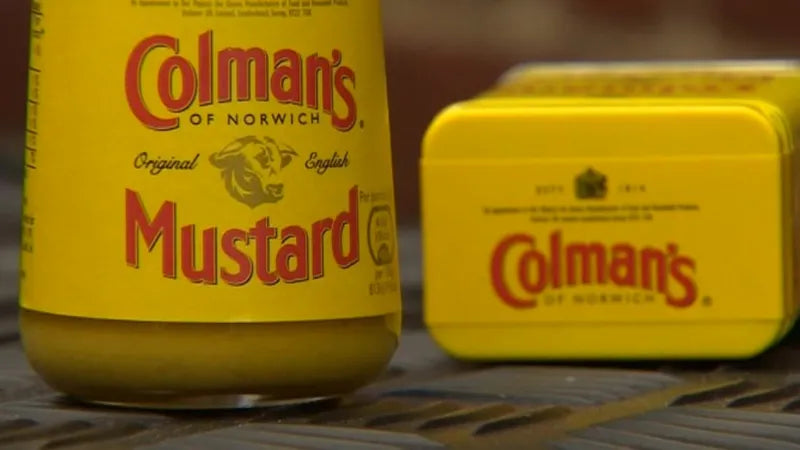
Colman’s Mustard: Britain’s Bold Yellow Staple Since 1814
A Fiery Beginning
In 1814, a young flour miller named Jeremiah Colman began producing mustard in a watermill at Stoke Holy Cross, just outside Norwich in England. What set him apart was his unique method: grinding brown mustard seeds and white mustard seeds separately before blending them. This technique gave a sharper, more fiery flavour that quickly gained a reputation.
At a time when most mustards were inconsistent and often bitter, Colman’s offered something distinct, smooth, hot, and reliable. It didn’t take long before households across Britain began to request it by name.
The Rise of the Yellow Tin
By the mid-1800s, Colman’s was no longer a local curiosity but a national brand. In 1855, the company introduced its now-famous bright yellow packaging. The bold bull’s head logo, chosen to symbolise strength and flavour, made it instantly recognisable. This simple design is still used today, making Colman’s one of the longest-standing branded food icons in Britain.
In 1866, Colman’s received the ultimate endorsement: a Royal Warrant from Queen Victoria. From then on, the fiery mustard of Norwich wasn’t just a household staple, but also a fixture on royal tables. The combination of everyday accessibility and royal prestige secured Colman’s place as part of the fabric of British dining.
Mustard Through the Ages
As the 19th century turned into the 20th, Colman’s Mustard became a fixture of British culture. It was there at Sunday roasts, slathered on ham sandwiches, stirred into gravies, and even served with cheese and biscuits.
During both World Wars, when food rationing stripped British diets of variety, Colman’s provided much-needed flavour. A little spoonful could turn a bland plate into something memorable, and families often considered it one of the few luxuries that kept meals interesting.
The Norwich Factory
By the late 1800s, Colman’s had expanded production massively, and the Norwich factory became one of the most important employers in the region. It wasn’t just a workplace but a community hub, Colman’s was known for looking after its workers, offering schooling, housing, and welfare long before such things were common.
Though large-scale production eventually shifted away from Norwich in the 21st century, the city remains tied to mustard in the British imagination. To this day, Norwich is still considered the “mustard capital” of the UK.
Colman’s and Advertising
Colman’s was also a pioneer in advertising. In the 19th century, when branded consumer goods were still a novelty, Colman’s embraced the idea of making its tins and jars instantly recognisable. Early posters, painted carts, and print ads all pushed the bull’s head and bold yellow colour scheme into public memory.
The brand even became known as “The Mustard Shop of the Nation.” In many ways, Colman’s was one of the first British grocery products to achieve both mass recognition and customer loyalty.
What Makes Colman’s Different
Filipinos familiar with mustard often think of the mild, sweet, American-style squeeze bottles commonly found on hotdogs. Colman’s is a completely different experience.
Its heat is sharp and fast, more like wasabi or horseradish than the mellow tang of American mustard. That’s because of the blend of brown and white seeds, which deliver a quick burst of heat that fades before it becomes overpowering. It’s the condiment equivalent of a wake-up call, one that British diners have embraced for more than two centuries.
The British Way to Use It
For Brits, Colman’s Mustard is inseparable from roast beef, where a spoonful on the side is as traditional as Yorkshire pudding or gravy. But its use doesn’t stop there. Ham sandwiches are elevated with a smear of Colman’s. Cheese boards become more interesting with mustard on the side. Gravy gets depth and character when a little is stirred in.
Colman’s also comes in both powdered form and ready-made mustard. The powder is particularly versatile: it can be reconstituted with water to create fresh mustard, but it is also used as an ingredient in sauces, dressings, marinades, and even baking.
Colman’s in the Filipino Kitchen
For Filipino kitchens, Colman’s is an exciting way to bring a new flavour dimension to familiar dishes:
Add a teaspoon to pork or chicken marinades to cut through sweetness.
Mix into potato salad or coleslaw for an extra kick.
Stir into a salad dressing with vinegar, oil, and honey for sharp balance.
Serve alongside lechon or longganisa for a fiery contrast to the fat.
Blend with mayonnaise to create a quick dipping sauce for fries or fried chicken.
Because Colman’s is potent, it only takes a small amount to transform a dish. That’s part of its appeal, a little tin or jar goes a very long way.
A Lasting Legacy
Colman’s Mustard has remained popular for over 200 years because it has never lost sight of what made it special: strength, flavour, and identity. From Jeremiah Colman’s Norwich mill to today’s global kitchens, the product has stayed true to its character.
For British expats in the Philippines, opening a tin of Colman’s is a taste of home. For Filipinos curious about British flavours, it’s an introduction to a classic that has stood the test of time.
Conclusion
Colman’s Mustard isn’t just a condiment. It’s history in a tin, a fiery symbol of British cooking that has crossed centuries and continents. Now available in the Philippines, it’s your turn to discover why no British roast, sandwich, or picnic is complete without it.
👉 Get your jar of Colman’s Mustard HERE
